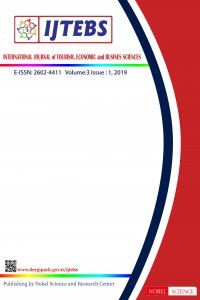TRADE UNIONS and THEIR SEARCH FOR ALTERNATIVE FUTURE
TRADE UNIONS and THEIR SEARCH FOR ALTERNATIVE FUTURE
In a time when change is accelerating and an awareness that dictates that values and organisations tobe reconsidered, and the concepts of the industrial society such as workmanship and employership are being restudiedas phenomena that change with new transitions, union managers too clearly state the need for restructuring.Due to technological development, the rate of white-collar workers in the workforce has risen against theblue-collar workers. An important change that has been a factor and a result of the change in economic prosperityand transition to high technology has been the rise of average levels of education and learning. The workforce,comprised mostly of highly-skilled white-collar workers who are better educated than previous generations andpossess a higher income level, has seen a change in attitude and behavior in the matters of unionization and laborstruggle. In addition to this, business managements also develop management techniques such as human resourcesmanagement that enable employees to participate, and develops conflict free relationships by establishing a directdialogue with employees with applications such as quality circles, team work and satisfaction surveys. Tradeunions are required to create new organizational structures to satisfy the needs of rapid change in technology andthe new position of the workforce with knowledge.On the other hand, developments in the aftermath of the 1980s led to neo-liberal policies taking overthe whole world. Dismissals under the name of flexible labour market, subcontracting, precarious work andunregistered employment are becoming more and more common. The working class has lost the benefits it gainedthrough organized struggle. In the face of the fact that traditional trade union organization is constantly weakening,it is a necessity to discuss alternative searches.If the workers’ unions will exist in the future, it will be extremely difficult for them to achieve this withtheir current traditional identities. In this respect, the time for the workers’ unions to create a new vision is longoverdue. In this study, a conceptual study on alternatives for the future vision search of unions will be presented.
Keywords:
Trade unions, Unionism, Workforce, Neo-Liberalism Flexible Labor Market,
___
- Ackers, P., And Payne, J. (1998). British Trade Unions And Social Partnership: Rhetoric And Strategy. The International Journal Of Human Resource Management, 9(3), 529-550.
- Akpınar, T. (2016). Sendikal Harekette Alternatif Arayışlara Dayanak Oluşturacak Sosyolojik Gerçekliğin Bilgisine Sahip Miyiz?. Emek Araştırma Dergisi, 2016/2, 51-67.
- Bacon, N. And Storey, J. (2000). New Employee Relations Strategies İn Britain: Towards Individualism And Collectivism. British Journal Of Industrial Relations, 38(3), 407-427.
- Bakır, H. (2018). Neo-Liberalizmin Hegemonyası Altında Türkiye Emek Piyasası. Çalışma Ve Toplum, 2018/
- Bingöl, D. (1990). İşyeri Disiplini Ve Çalışma Barışı. Basisen Eğitim Ve Kültür Yayınları, Yayın No. 21, İstanbul.
- Bronfenbrenner, K. (1997). The Role Of Union Strategies İn Nlrb Certication Elections. Industrial And Labor Relations Review, 50(2), 195-212.
- Brown, W. (2000). Putting Partnership İnto Practice İn Britain. Cambridge: Esrc Centre For Business Research, University Of Cambridge.
- Centel, T. Değişim İçinde Sendikalar. Mercek, Türkiye Metal Sanayicileri Sendikası Dergisi, Nisan 1996, 41-47.
- Coşkun, M., K. (2017). İşçi Sınıfı Kültürü, Deneyim Ve Gündelik Hayat. Emek Araştırma Dergisi, 2017/1, 41-54.
- Davıs, K. (1988). İşletmede İnsan Davranışı. Çev. Kemal Tosun Vd. İstanbul: İ.Ü. İşletme Fakültesi Yayın No. 199.
- Dereli, T. (1975). Aydınlar, Sendika Hareketi Ve Endüstriyel İlişkiler Sistemi. İstanbul.
- Dereli, T. (1992). Endüstri İlişkilerinde Çatışmadan Uzlaşma Ve İşbirliğine Dayalı Sistemlere Geçiş. Mess İşveren Gazetesi, Ekim 1992. Drucker, F., P. (1994). Kapitalist Ötesi Toplum. İstanbul: İnkılap Kitabevi.
- Erbaş, H. (2017). Sınıf Çalışmalarında Kültür Ve Gündelik Yaşamın Yükselişi: Tarihsel Bir İzlek Ve Gelecek ‘Umudu’. Emek Araştırma Dergisi, 2017/1, 9-30.
- Gall, G. (2004). British Employer Resistance To Trade Union Recognition. Human Resource Management Journal, 14(2), 36-53.
- Guest, D., E., And Pecceı, R. (2001). Partnership At Work: Mutuality And Balance Of Advantage. British Journal Of Business Ethics, 261-278.
- Kantaş, Ö. (2017). Sendikalaşmayı Kültürlerarası Psikoloji Çerçevesinde Ele Almak: İşsizlik Ve Milli Gelirin Ötesinde Kültürün Etkisi. Çalışma Ve Toplum, 2017/2, 721-740.
- Kaya – Millioğulları, Ö. (2017). Sendikaya Bağlılık Üzerine Bir Alan Araştırması. Çalışma Ve Toplum, 2017/4, 2069-2092.
- Kelly, J. (1998). Rethinking Industrial Relations: Mobilization, Collectivism And Long Waves. London: Routledge.
- Kelly, J. (2004). Social Partnership Agreements İn Britain: Labor Cooperation And Compliance. Industrial Telations, 19(5), 400-414.
- Kessler, I., And Purcell, J. (2003). Individualism And Collectivism İn Industrial Relations. P. Edwards İçinde, Industrial Relations: Theory And Practice (2b., S.313-337). Malden: Blackwell Publishing.
- Kılıç, S. (2016). Sendikaların Yeniden Canlanması İçin İki Rakip Strateji: Paydaşlık Ve Örgütlenme, Çalışma Ve Toplum, 2016/3, 1203-1230.
- Koray, M. (1992). Endüstri İlişkileri, Basisen Eğitim Ve Kültür Yayınları, İzmir.
- Krasuckı, H. (1987). Çağdaş Sendikaya Evet. İstanbul: Amaç Yayıncılık.
- Lıpetz, A. (1982). Towards Global Fordism?. New Left Review, 132, 33-47.
- Robınson, I. (2008). What Explains Unorganized Worker’s Growing Demand For Unions? Labor Studies Journal, 33(3), 235-243.
- Tuncay, M. (1979). From the introduction of “Sendikacılık ve Siyaset”, written by Alplaslan Işıklı.
- Vısser, J. (2006). Union Membership Statistics İn 24 Countries. Monthly Labor Review, January, 38-49.
- Waddıngton, J. (2003). Trade Union Organization. P. Edwards İçinde, Industrial Relations: Theory And Practice (S. 214_254). Malden: Blackwell Publishing.
- Başlangıç: 2017
- Yayıncı: Nobel Bilim ve Araştırma Merkezi Limited
Sayıdaki Diğer Makaleler
DEFINITION AND BENEFITS OF BUSINESS TOURISM IN THE CONTEXT OF GLOBALIZATION
MUTFAK SANATLARINDA GÖSTERGE BİLİMİNİN TABAK SUNUMLARINA YANSIMALARI
Savaş BÖYÜKYILMAZ, Melek YAMAN2
TURİZM İŞLETMELERİNDE ELEKTRONİK TİCARETİN ETKİSİ
Sami KARACAN, Sibel ÇIFTÇIOĞLU
Aysun ÇELIK ÇANGA, Gizem KÜÇÜK, Tuba AKMAN
SANALLIK ALGISININ, İŞ YERİ YALNIZLIĞI VE ÖRGÜTSEL İLETİŞİM ÜZERİNDEKİ ETKİSİ
Canan KOÇER, Elçin YEŞIL, Hediye YÜRÜYEN
TARİH İÇİNDE KOCAELİ KARTEPE YÖRESİNE YAPILAN GÖÇLERDE UYGULANAN İSKÂN POLİTİKALARI
Yüksel GÜNGÖR, Sami KARACAN, Esin KARACAN
Füsun ERDURAN NEMUTLU, Ümit YILMAZ
ŞİFA BAHÇELERİ VE TURİZMDEKİ YERİ
